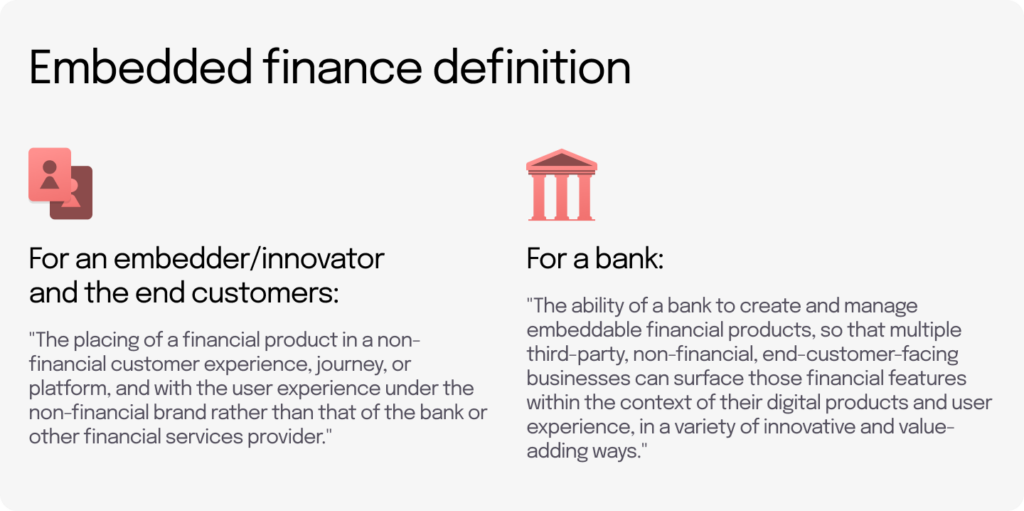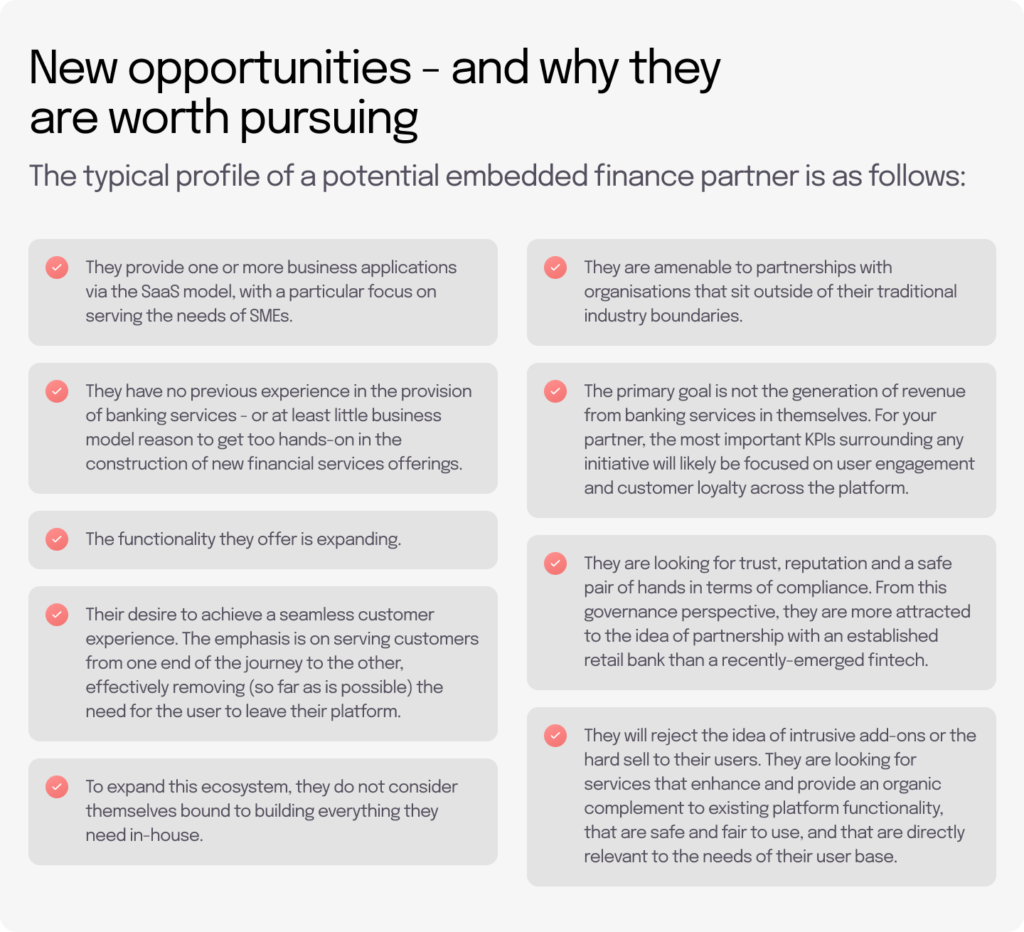For retail banking, embedded finance is the next logical step towards meeting shifting customer expectations, servicing previously under-exploited market segments and preserving business value.
Far from being too difficult to contemplate, the embedded finance model of distribution is impossible to ignore.
When Apple launched its high-yield savings account earlier this year, this wasn’t just another story of Big Tech attempting to park its tanks on the financial sector’s lawn.
The real story is about an established banking player – in this case, Goldman Sachs. It’s about taking a fairly standard core banking product, enhancing it a little, and making it available to Apple. Apple gets a genuinely attractive new addition to its ecosystem, while the bank gets access to a lucrative and previously untapped stream of customers.
This is embedded finance in action. And if there were any doubts as to the potential of this model, the stats tell an even more compelling story:
- For customers, it is fast becoming second nature to carry out financial transactions as part of their existing behaviour flow on non-financial platforms. In terms of transaction value, embedded finance is predicted to exceed $7 trillion in the US alone by 2026, or over 10% of total US transaction value.
- Embedded finance is predicted to generate $230 billion revenue annually by 2025, a 10x increase from $22.5 billion in 2020.
- According to McKinsey, products suitable for offering via embedded finance could ultimately account for as much as 50% of banking revenue pools by 2025.
Here’s a closer look at what embedded finance really means for banks – and why it’s impossible to ignore…
Embedded finance for banks: what it really means
Some myth-busting is probably useful here. For the avoidance of doubt, embedded finance is not “more or less the same thing” as the earlier banking as a service (BaaS) model.
With BaaS, you are basically offering up your infrastructure and services to be consumed by fintechs and similar non-traditional banking or payments companies. Those partners then remix those services to suit their own finance-related products and services. In BaaS your fintech partner provides the front-end interface and customer experience in the case of each new distribution channel.
By contrast, embedded finance refers specifically to the integration of financial services and products into non-financial platforms. For banks, these products may include not just pre-existing capabilities from your banking product catalogue (e.g. current accounts, debit cards and credit facilities), but also more recent innovations that are in your catalogue already or are still in the product development pipeline (e.g. e-money accounts, peer-to-peer payments facilities, virtual or single use cards, tokenisation and credit products built around the BNPL theme).
Crucially, embedded finance involves entirely new categories of partner. They are not fintechs seeking to piggyback on your infrastructure. Typically, they will be business software vendors who distribute their product via the software-as-a-service (SaaS) model. This might be e-commerce platforms (Shopify, for instance), HR management tools, payroll, accounts packages, customer relationship management (CRM), enterprise asset management or enterprise resource planning (EAM / ERP), or collaboration / project management tools.
This list is meant to be illustrative rather than comprehensive; the key point being that although they are likely to be established names in their particular field, these potential partners will, in all likelihood, have no previous track record in the provision of financial or banking services. If your services are embedded into their platform, it will be ancillary to – or an enhancement of – their core offerings; not their primary raison d’etre (a key difference between embedded finance and most BaaS initiatives).

Have we been here before? The real challenge from big tech
Embedded finance needs to be looked at not as an entirely new departure, but as a continuation of something that has been happening for decades: i.e. long-established players in the banking sector adapting their distribution models, catalogues and approach to customer service in the face of new behaviour, new tech and new competitors.
Rewind a decade or so ago to the emergence of Starling, Revolut and a whole host of other neobanks and consumer-facing fintechs. The trending question was “Is this the future of banking?”. As it turned out, the answer was both yes and no. Incumbents recognised the challenge; they stepped up by overhauling their tech stacks and their customer experiences. The arrival of new competitors certainly helped change the face of banking, but the existential threat to incumbents turned out to have been overstated.
So where will the next challenge come from? All eyes are on Big Tech. In their favour, the likes of Google, Apple and Meta appear to hold two winning cards over traditional banks. First off, they more or less control the technology that will drive the transactions of the future (the cashless society). Secondly, unlike many of the rather flaky, undercapitalised fintechs that have come and gone over the last few years, these businesses have vast, loyal customer bases.
However, another factor in Big Tech’s favour – and one which can easily be overlooked – is their focus on digitally native customer experience. Analysing, understanding and responding to customer behaviour purely in digital UX contexts is second nature to these companies. To survive and thrive, retail banks will benefit from adopting a similar approach.
For instance, imagine a seed-stage industrial-design business. The founder has investor capital to manage, suppliers to pay and short-term cash flow deficits to bridge from time to time. Dig a little deeper and you discover that given the choice, she would much prefer to access and manage her banking services not from a retail banking platform – or even through a trendy fintech app – but through the project management suite her various teams use day in and day out.
Responding to this need means embracing embedded finance.

For any banking strategist with a mandate to boost retail customer acquisition, the most likely use cases for embedded finance provide a compelling proposition. The overlap between SME end users and the most likely embedded finance use cases is significant – to the point of being impossible to ignore. We are talking here about customers who have significant revenue potential at a cohort level, but are not, at present, very well served on an individual level via traditional distribution and service modes.
An addressable market that is at present, under-exploited. An opportunity to tap into new and growing customer bases at low cost. And the opportunity to respond effectively to the market challenge from Big Tech by responding effectively to customer behavioural preferences. For these reasons, closer consideration of embedded finance needs to be at the top of your priority list.
Want to chat to a Weavr expert about embedding finance for you? You can talk to an expert here.
Embedded finance for retail banks is coming, and Weavr can help you succeed.



